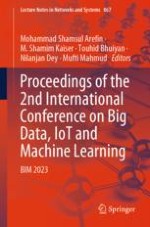2024 | Buch
Proceedings of the 2nd International Conference on Big Data, IoT and Machine Learning
BIM 2023
herausgegeben von: Mohammad Shamsul Arefin, M. Shamim Kaiser, Touhid Bhuiyan, Nilanjan Dey, Mufti Mahmud
Verlag: Springer Nature Singapore
Buchreihe : Lecture Notes in Networks and Systems
